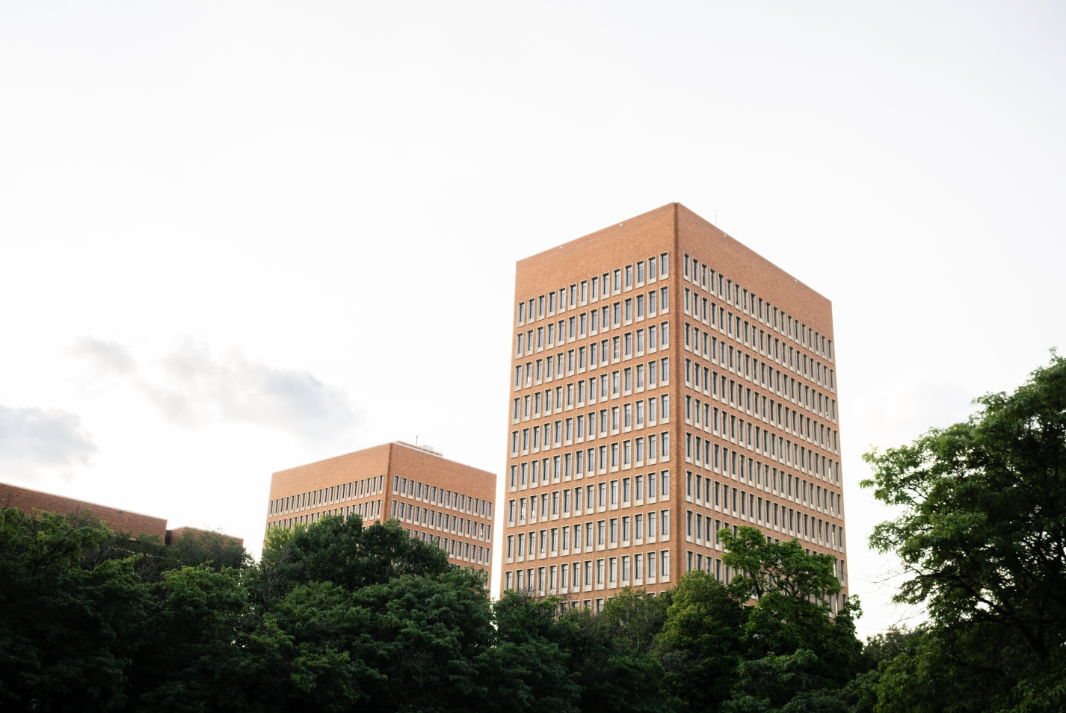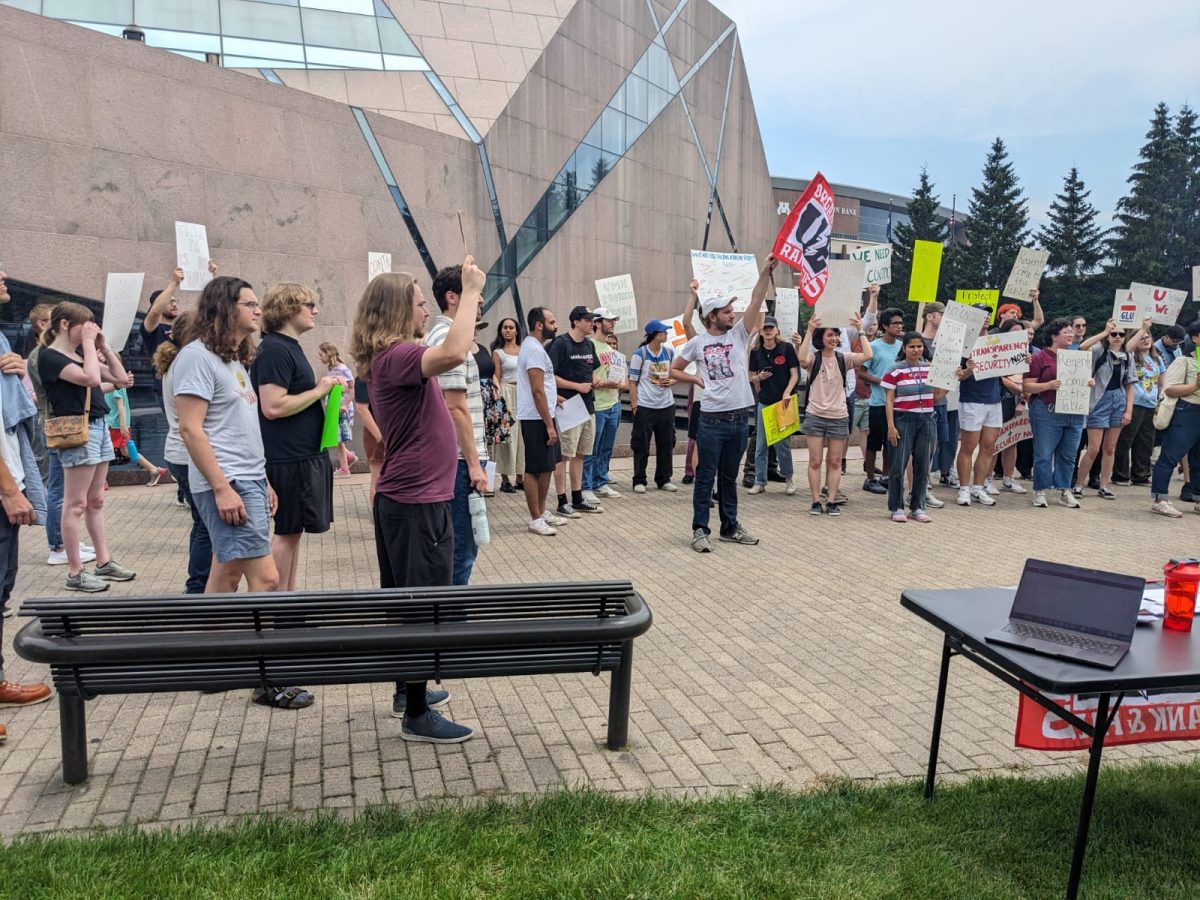Over the last decade, housing development close to the University of Minnesota campus has skyrocketed, bringing with it legal disputes, choices and more business to the area.
Two apartments have gone up in and around Dinkytown in the last few years, bringing up the value of nearby properties and their taxes, making it difficult for some local businesses to keep up. Increased development, mainly from management companies based outside of Minnesota, has also brought more legal dilemmas for student renters than in the past.
When the Student Legal Service (SLS) office opened, most students sought help for criminal cases because most people lived away from campus due to a lack of housing options, said SLS attorney Shana Tomenes. Over the past 10 years, fewer students have been committing crimes.
Now, the vast majority of the office’s casework is related to housing.
Most of the students Tomenes works with are on leases with corporate, out-of-state landlords, as opposed to the locally based landlords who own many of the properties near campus.
With property management companies not based in Minnesota, leases sometimes do not reflect an understanding of state law, Tomenes said.
Many of the apartments in Dinkytown are managed by companies with home offices in Illinois, Colorado, New York and California, with a handful based locally in Minnesota.
Some recent legal changes include requiring the unit number on a lease, not charging for repairs, giving 24 hours notice before entering the property and prorating rent, meaning if you move in or out halfway through the month you are not supposed to pay a full month’s rent, Tomenes said.
“It’s not typical in the industry to have to pay a full month’s rent and not live in a home for the full month,” Tomenes said, adding that students with Undergraduate Student Government (USG) advocated strongly for the bill.
The University keeps a list of non-compliant properties that have had multiple lawsuits filed against them by renters. Properties on the list cannot advertise vacancies on that property for at least one year through Off-Campus Living’s services.
Currently, the properties on the list are Identity Dinkytown, owned by CA Ventures; the Minneapolis Rental Property Group, LLC, or MRPG; Millennium Management; and Prime Place, which rebranded as The Arrow Apartments.
The University also provides support for student renters through a roommate finder, managing two Facebook groups for University students seeking roommates and sublets and sponsoring an off-campus housing fair in the fall.
To Tomenes, one sign of a good landlord is responsiveness to repair issues, part of which involves the tenant knowing who they could call for an emergency, like water overflowing in a bathtub. Minnesota law says landlords must always respond to loss of electricity, sanitation and other essential services within 24 hours after notice.
“Sometimes, you’ll be in a situation where — this happens for local landlords — you can not get them on the phone,” Tomenes said. “Or, you live in a big apartment complex and there is no one staffing that bottom front desk.”
Student renters can get a feel for how responsive a landlord is by how quickly they call back during the leasing process, Tomenes added.
“There are excellent out-of-town landlords, and there are really bad local landlords,” Tomenes said.
Tomenes said she gets cases from time to time where a student thought an apartment marketing itself as “student housing” was connected to the University.
“It places trust that they give the University in the hands of a landlord that’s not affiliated with the University,” Tomenes said. “That seems unfair to me.”
There are roughly 10 apartments near the University marketing themselves as “student housing,” with more who self-designate as “off-campus housing” on their websites.
It can also be a helpful way to brand by letting students know they will be living in a community with others at the same stage of life, Tomenes said, but landlords should be clear that they are not affiliated with the University to avoid misconceptions.
One benefit of having many housing options close to campus is that students have choices and are less likely to believe they are risking not having housing by not signing a lease early, Tomenes said.
“Meaningful choice is important, and to the extent that additional places are creating meaningful choice, that seems great,” Tomenes said.
Having a variety of housing options, from high-rise apartments to rental houses to family-oriented housing, is important for meeting the needs of different college students, wrote Off-Campus Living Director Kendre Turonie in an email to The Minnesota Daily. Turonie is a non-voting member of the Daily’s board of directors.
Proximity to campus is a big draw for students, Turonie wrote, and second-year students tend to be drawn toward high-rise apartments with amenities and staffed front desks, which parents also prefer. After their second year, many students look to rent houses for more privacy and independence.
Housing access, at what cost?
Whether increased development of apartments near campus benefits students is complicated, said Katie Smithberg, local government coordinator for USG. There may be more available units, but students need affordable places to live, and young renters are in a vulnerable position.
Rent control was a priority for USG last spring because it would help ease the burden on students also paying for tuition, bills and groceries — and the cost of rent is ever-increasing in Minneapolis, Smithberg said.
The Minneapolis City Council struck down a rent control ordinance last year during a meeting at which three Muslim members were absent due to the Eid al-Adha holiday.
“We need something that is going to put tenants first,” Smithberg said.
“Living close to campus is often the way for students to be able to do what they need to do, to get where they need to go,” said USG Vice President Sara Davis, but the expensive rent prices create a dilemma.
Keeping up with high rent prices is at odds with the amount of work that already goes into being a college student, Davis said. The more time a college student spends working outside of class, the more likely their GPA will suffer — potentially risking scholarship eligibility.
“We should end this skyrocketing development for what looks like competition to charge the highest rent around here,” Davis said. “It’s unsustainable for students in the area.”
Much of the development near campus is a “race to lower the student experience… and charge as high as you can,” Davis said, and it is not a problem unique to the University.
The company that owns Identity Dinkytown is also being sued for a property they own near the University of Chicago.
Bring your neighbors up with you
Nearly all of the apartment buildings in Dinkytown and nearby are roughly a decade old, with more older buildings around Stadium Village. In the last several years, two more have gone up — The Fieldhouse and Identity Dinkytown.
The new construction has helped boost the market value of properties around them, with “student housing” apartments increasing by $1 million to almost $20 million.
The highest-value apartment, The Marshall, grew from $100 million to $108 million.
As someone bids up the price of a piece of land, they also bid up the price of nearby properties because the property assessor will look at land sales in the area, said Steve Brandt, president of Minneapolis Board of Estimate and Taxation.
New construction that requires charging a higher price generates more income for a property replacing a house or small apartment building, Brandt added.
For properties nearby, their value may also go up, but their tax rate would be driven down because the higher-value properties are paying a greater share of the property taxes, Brandt explained.
The $2.8 billion in apartment construction in Minneapolis over the past four years has helped to bring down the property tax rate for many properties citywide, according to Brandt.
Hennepin County saw $3 billion in property value growth in 2022 from the previous year, bringing down the property tax rate for many properties, Brandt said.
“Not a commercial retail district like it used to be”
Some local establishments that characterized the area have been driven out of business due to higher rental costs, according to Turonie. These changes may not be noticeable to current students, but they are to long-term residents and visiting alumni.
A decade ago, Kent Kramp said he and other business owners in Stadium Village saw multiple smaller buildings torn down and replaced by high-rise apartments, including an Arby’s and a convenience store.
For several years, the Raising Cane’s Kramp owns in Stadium Village saw the most growth year over year out of any restaurant in the chain’s system thanks to the increased demand of new residents in the area.
“Having big, massive apartment buildings up 15th, it only helps,” Kramp said. “It’s how people get onto campus, get off campus.”
The more recent growth in Dinkytown has absolutely increased sales, Kramp said, though that Raising Cane’s location opened in 2018.
The biggest apartments to go up in Dinkytown after the Sydney Hall addition to the Dinkydome — The Marshall and The Venue — were controversial at the time, Kramp said. Since moving in five years ago, Kramp said he has seen several new buildings go up, as well as others nearby, such as the Fieldhouse.
One difficulty for Dinkytown businesses has been adjusting to an increasing need for litter cleanup and street sweeping with more residents in the community.
Dinkytown has a Special Service District, so the city collects an assessment from property owners to pay for snow removal and cleaning in the neighborhood. Because the assessment is based on the footage of a property’s perimeter, skyward development and the residents who move in did not change the amount owed.
“If you were The Marshall, you’d still be paying a huge portion of it, but if you’ve got five stories of students living there, that’s a lot of new bodies not being taken into account,” Kramp said. “It’s always a challenge between trying to keep the historic feeling and the small-town feel while also providing more housing and affordable places for people to live.”
The Special Service District board met last year to work out a fair increase to address the disparity, Kramp said.
“If you don’t have a clean neighborhood, people aren’t gonna want to come eat there, shop there, visit,” Kramp said. “It’s one of those things where you have to do it in order to keep businesses thriving.”
Shopping habits of Dinkytown residents have reflected shifting consumer habits generally, Kramp said.
On one occasion, he heard a manager at The Marshall talking about delivery drivers frequenting the outside of the building.
“They said, ‘We have people that live above the Target, and they’re having toilet paper delivered by Amazon,’” Kramp said.
When the Target Express location opened in Dinkytown, it was the first of its kind, according to Kramp.
“Nowadays, people are less likely to be going out and doing experimental businesses, or there are more factors limiting what they want to go out and try,” Kramp said.
Shops like Goldy’s Locker Room, Hideaway and Royal Cigar and Tobacco are still around, but Dinkytown is “not a commercial retail district like it used to be,” Kramp said.
This article has been updated.






















